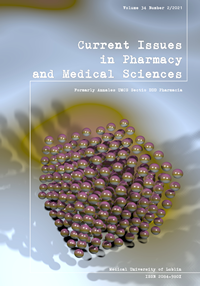Histopathological nephrotoxic features of high oral doses of ubiquinone in rats
DOI:
https://doi.org/10.2478/cipms-2021-0014Keywords:
nephrotoxicity, histopathology, rats, co-enzyme Q10Abstract
Co-enzyme Q10 (Co-Q10) plays a key role in the cellular respiration for the production of ATP. The toxicity of quinones to the kidney appears to depend on variety of factors, including genetic polymorphisms and the individual’s comorbidites. The aim of the present study was to assess histologically the nephrotoxic effects of 6 weeks daily oral intake of Co-Q10 in experimental animals.
Twenty-five Wistar rats weighing between 220-270 g were randomly divided into two groups: experimental “treated” and control “untreated” groups (n=15, n=10, respectively). The animals of the experimental group received 300 mg/kg daily dose of gelatinous capsules of Co-Q10 by oral gavage for six weeks. At the end of the study, all animals were sacrificed under general anesthesia and samples of the kidneys were excised for microscopic histopathological assessment of renal tissue using stain. The experimental group showed a range of mild to severe dilatation of Bowman’s space, with a mean corpuscular diameter of 294±38 µm that was significantly higher (p <0.05) than that of the untreated control group 208±31 µm. Shrinkage to complete destruction of the glomeruli was observed in the experimental group only. The long-term use of high doses of Co-Q10 had revealed a selective nephrotoxicity towards podocytes. This might be a risk factor leading to renal proximal tubular necrosis in rats and the subsequent renal function deterioration.
References
1. Awad AM, Bradley MC, Fernandez-Del-Rio L, Nag A, Tsui HS, Clarke CF. Coenzyme Q10 deficiencies: pathways in yeast and humans. Essays Biochem. 2018;62:361-76.
2. Lee SQ, Tan TS, Kawamukai M, Chen ES. Cellular factories for coenzyme Q10 production. Microb Cell Fact. 2017;39:1-16.
3. Macunluoglu B, Kaya Y, Atakan A, Ari E, Kaspar C, Demir H. Serum CoQ10 levels are associated with coronary flow reserve in hemodialysis patients. Hemodial Int. 2013;17:339-45.
4. Singh RB, Kumar A, Niaz MA, Singh RG, Gujrati S, Singh VP. Randomized double blind placebo controlled trial of CoQ10 in chronic renal failure. J Nutr Environ Med. 2000;10:281-8.
5. Mehmetoglu I, Yerlikaya FH, Kurban S, Erdem SS, Tonbul Z. Oxidative stress markers in hemodialysis and peritoneal dialysis patients, including coenzyme Q10 and ischemia-modified albumin. Int J Artif Organs. 2012;35:226-32.
6. Anupama S, Pragnesh P, Nishkruti M, Pankti D. Effect of coenzyme Q10 alone and it’s combination with pentoxifylline in cisplatin-induced nephrotoxicity in rats. J Pharm Sci Bioscientific Res. 2016;6: 790-800.
7. Sayed-Ahmed MM, Nagi MN. Thymoquinone supplementation prevents the development of gentamicin-induced acute renal toxicity in rats. Clin Exp Pharmacol Physiol. 2007;34:399-405.
8. Tamura Y, Tanabe K, Kitagawa W, Uchida S, Schreiner GF, Johnson RJ, Nakagawa T. Nicorandil, a K(atp) channel opener, alleviates chronic renal injury by targeting podocytes and macrophages. Am J Physiol Renal Physiol. 2012;303:F339-49.
9. Ragheb A, Attia A, Eldin WS, Elbarbry F, Gazarin S, Shoker A. The protective effect of thymoquinone, an anti-oxidant and anti-inflammatory agent against renal injury: a review. Saudi J Kidney Dis Transpl. 2009;20:741-52.
10. Nicolantonio JJ, Bhutani J, McCarty MF. Coenzyme Q10 for the treatment of heart failure: a review of the literature. Open Heart 2015;2:e000326.
11. El-Sheikh AA, Morsy MA, Mahmoud MM, Rifaai RA, Abdelrahman AM. Effect of coenzyme-q10 on Doxorubicin-induced nephrotoxicity in rats. Adv Pharmacol Sci. 2012;2012:981461.
12. Abdullah AG. Age related changes of submandibular salivary glands: Anatomical and histological study. MSc. Thesis; 2005
13. Al Khateeb IA. A histological study on the development of human epidermis. MSc. Thesis; 1987:52-4.
14. Littarru GP, Tiano L. Bioenergetic and antioxidant properties of coenzyme Q10: Recent developments. Mol Biotechnol. 2007;37:31 7.
15. Barakat A, Shegokar R, Dittgen M. Coenzyme Q10 oral bioavailability: effect of formulation type. J Pharm Inv. 2013;43: 431-51.
16. Al-Megrin WA, Soliman D, Kassab RB, Metwally DM, Ahmed EAM, El-Khadragy MF. Coenzyme Q10 activates the antioxidant machinery and inhibits the inflammatory and apoptotic cascades against lead acetate-induced renal injury in rats. Front Physiol. 2020;11:64.
17. López-Lluch G, Del Pozo-Cruz J, Sánchez-Cuesta A, Cortés-Rodríguez AB, Navas P. Bioavailability of coenzyme Q10 supplements depends on carrier lipids and solubilization. Nutrition. 2019;57:133-40.
18. Alkharfy KM, Al-Daghri NM, Al-Attas OS, Alokail MS. The protective effect of thymoquinone against sepsis syndrome morbidity and mortality in mice. Int Immuno-pharmacol. 2011;11:250-4
19. Galli F, Piroddi M, Annetti C, Aisa C, Floridi E, Floridi A. Oxidative stress and reactive oxygen species. Contrib Nephrol. 2005;149:240-60.
20. Gokbel H, Gokbel H, Turk S, Okudan N, Atalay H, Belviranli M, Gaipov A, Solak Y. Effects of coenzyme Q10 supplementation on exercise performance and markers of oxidative stress in hemodialysis patients: A double-blind placebo-controlled crossover trial. Am J Ther. 2016;23:e1736-e1743.
21. Koyner JL, Sher Ali R, Murray PT. Antioxidants. Do they have a place in the prevention or therapy of acute kidney injury? Nephron Exp Nephrol. 2008;109(4):e109-17.
22. Durvasula RV, Shankland SJ. The renin-angiotensin system in glomerular podocytes: mediator of glomerulosclerosis and link to hypertensive nephropathy. Curr Hypertens Rep. 2006;8:132-8.
23. Farrag AR, Ibrahim RA, El-Sayed SN. Protective effect of Coenzyme Q10 against gentamicin induced acute renal failure in mice. J Biosci Appl Res. 2016;2:401-6.
Downloads
Published
Issue
Section
License
Copyright (c) 2021 Authors

This work is licensed under a Creative Commons Attribution-NonCommercial-NoDerivatives 3.0 Unported License.


